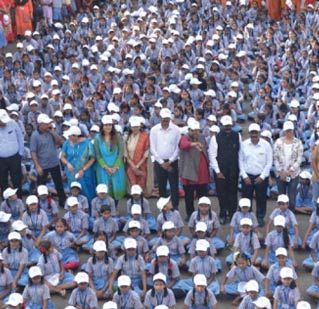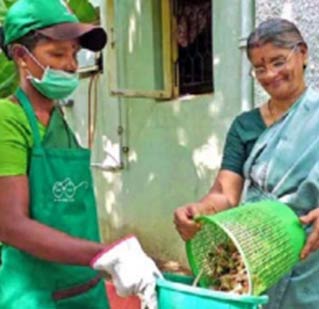The Government of India (GOI) launched the Swachh Bharat Mission (Urban) [SBM (U)], with the vision of ensuring hygiene, waste management and sanitation across the nation, as a tribute to Mahatma Gandhi on his 150th birth anniversary, to be celebrated in the year 2019. SBM (Urban) is being implemented by the Ministry of Housing and Urban Affairs (MHUA). Key thrust areas of the mission include:-
- Elimination of open defecation.
- Eradication of Manual Scavenging by converting insanitary toilets to sanitary.
- Modern and Scientific Municipal Solid Waste Management.
- Effecting behavioural change regarding healthy sanitation practices.
- Awareness generation about sanitation and its linkage with public health.
-
Capacity Augmentation for Urban Local Bodies (ULBs) to create an enabling.
environment for private sector participation The mission also focuses on improving the levels of cleanliness through Solid Waste2 Management activities. The mission targets coverage of all statutory towns. It is important to note that the Open Defecation Free (ODF) city/ward is the ultimate outcome envisaged under SBM (U). A city / ward can be notified/ declared as ODF city/ ODF ward if, at any point of the day, not a single person is found defecating in the open. ODF is the termination of faecal-oral transmission, defined by
a. No visible faeces found in the environment/surroundings
b. Every household as well as public/community institutions are using Safe option for disposal of faeces.
It is important to note that the Open Defecation Free (ODF) city/ward is the
ultimate outcome envisaged under SBM (U). A city / ward can be notified/ declared
as ODF city/ ODF ward if, at any point of the day, not a single person is found
defecating in the open.
ODF is the termination of faecal-oral transmission, defined by
a) No visible faeces found in the environment/surroundings and
b) Every household as well as public/community institutions are using Safe
option4 for disposal of faeces.
Goal
To achieve “Swachh Bharat” by 2019
Key components of SBM (U)
The Mission has the following key components - Household
- Toilets
- Community
- Toilets Public Toilets Solid Waste
- Management
- Information,
- Education and
- Communication (IEC)
- Public Awareness
- Capacity Building &
- Administrative and
- Office expenses
Eligibility Criteria for Household Toilets under SBM (Urban)
- Households Engaging in Open Defecation: The target group for the construction of household toilets includes 80% of urban households engaging in open defecation. sanitary Toilets: All households with insanitary latrines are eligible for assistance.
- Selection of Beneficiaries: The selection of beneficiaries is based on the strategy of Urban Local Bodies (ULBs) and follows state-specific guidelines. Beneficiary households are decided at the ULB and state levels.
- Special Focus Groups: Priority is given to households with vulnerable sections, including pensioners, girl children, pregnant, and lactating women.
- Technology Options: Various technology options are available for individual household toilets, including twin pit toilets, septic tank systems, bio-digester toilets, bio-tank/bio-toilet, and other safe and sanitary options.
- Financial Assistance: The unit cost for household toilets ranges from Rs. 16,000 to Rs. 20,000 for states, with states contributing a minimum of 25% of the funds. For Union Territories (UTs), the unit cost is Rs. 5,333, with variations based on legislative status. Additional financial assistance is available for North Eastern and Himalayan States.
- Operational Guidelines: For further information on the selection of beneficiaries, technology options, and financial assistance, operational guidelines provided by SBM (Urban) should be referred to.
By meeting these eligibility criteria and adhering to the guidelines, households can avail assistance for the construction of toilets under the Swachh Bharat Mission (Urban).
Sanitation
Individual Household Latrine (IHHL)
Mission Target: 9 Lacs
Constructed: 9 Lacs
Community Toilet (CT)
Mission Target: 30781
Constructed: 35708
Public Toilet (PT)
Mission Target: 32670
Constructed: 33673
Pink Toilet
Mission Target: 63451
Constructed: 69381
Urinal
Mission Target: 8587
Constructed: 6746
Open Defecation Free
171 cities ODF
441 cities ODF+
40 cities ODF++
0cities Water+
Waste Management
D2D Garbage Collection (Wards)
Collection: 12022
Segregation: 12022
Waste
Generated (TPD): 14468 k+
Processed (TPD): 9588 k+
Garbage Free Star Rating (Cities)
7 Star Rating 0
5 Star Rating 1
3 Star Rating 4
1 Star Rating 6
Remediation of Legacy Dumpsites
Waste to be remediated
Total Remediate: 58.00Lacs MT
Total Quantity: 91.00Lacs MT
Benefits from the Key Activities and Financial Assistance provided under the Swachh Bharat Mission (Urban) are manifold and contribute significantly to improving sanitation and hygiene practices in urban areas. Here are some of the key benefits:
-
Household Toilets:
Elimination of open defecation: By targeting 80% of urban households engaging in open defecation, the SBM (U) aims to eradicate this unsanitary practice, leading to improved public health outcomes.
Sanitation improvement: Conversion of insanitary toilets to sanitary latrines ensures better sanitation facilities, reducing the risk of waterborne diseases and improving overall hygiene standards.
Targeted assistance: The financial assistance provided helps households in constructing toilets, making sanitation facilities more accessible and affordable, particularly for vulnerable sections of society. -
Community Toilets (CTs):
Increased access: Community toilets cater to urban households facing space constraints for individual toilets, ensuring that a larger segment of the population has access to sanitation facilities.
Social inclusivity: By targeting beneficiary household groups regardless of their living conditions, CTs promote social equity and inclusion, addressing the needs of marginalized communities.
Financial support: The financial assistance provided encourages ULBs and states to invest in community toilet projects, facilitating the expansion of sanitation infrastructure. -
Public Toilets:
Enhanced urban infrastructure: Provision of public toilets in areas with high footfall improves the overall urban environment and promotes tourism and economic activities.
Inclusive design: Public toilets with facilities for men, women, and the disabled ensure accessibility for all, fostering a more inclusive and equitable urban landscape.
Sustainable maintenance: Mandating a minimum 5-year maintenance contract ensures the longevity and usability of public toilet facilities, promoting sustainability in urban sanitation management. -
Solid Waste Management:
- Environmental sustainability: Implementation of solid waste management projects contributes to cleaner and healthier urban environments by promoting proper waste disposal and recycling practices.
Economic opportunities: Initiatives like decentralized waste management systems create employment opportunities, particularly for economically weaker sections, while generating revenue through the sale of recyclable materials.
Long-term viability: By encouraging user charges and establishing mandatory waste management regulations, the SBM (U) ensures the long-term sustainability of waste management initiatives in urban areas. -
Information, Education, and Communication (IEC) Activities:
Behavioral change: IEC activities raise awareness about sanitation and hygiene practices, leading to positive behavioral changes among the urban population and reducing the prevalence of open defecation and manual scavenging.
Public health promotion: By emphasizing the link between sanitation, public health, and environmental conservation, IEC campaigns contribute to improved health outcomes and overall well-being in urban communities. -
Capacity Building and Administrative Expenses:
Institutional strengthening: Capacity building initiatives empower state and ULB officials to effectively implement SBM (U) projects, enhancing the efficiency and effectiveness of urban sanitation programs.
Knowledge dissemination: Training programs and e-learning modules ensure that relevant stakeholders are equipped with the necessary skills and knowledge to promote sanitation and hygiene practices at the grassroots level, contributing to the sustainability of the mission.
The application process for accessing benefits under the Swachh Bharat Mission (Urban) involves several steps, depending on the specific component or assistance being sought. Here's a generalized outline of the application process:
- Determine if you meet the eligibility criteria for the particular component or financial assistance program under SBM (Urban). Eligibility criteria may vary based on factors such as residency, household income, and location.
-
Obtain the relevant application form from the designated authorities, such as the Urban Local Body (ULB) or State Government offices responsible for implementing SBM (Urban).
- Fill out the application form accurately, providing all necessary details and supporting documentation as required. - Submit the completed application form along with supporting documents, such as proof of residency, income certificate, and any other documents specified in the application guidelines. Authorities will verify the submitted documents to ensure compliance with eligibility criteria and authenticity.
- Once the documents are verified, beneficiaries are selected based on predetermined criteria and guidelines established by the ULB or State Government. Selection may prioritize vulnerable groups or areas with the greatest need for sanitation facilities.
- Upon successful verification and beneficiary selection, the application is approved by the relevant authorities. Applicants are notified of the approval status through official channels, such as written communication or online portals.
- For programs involving financial assistance, funds are disbursed to approved beneficiaries according to the designated allocation mechanism. Beneficiaries may receive financial assistance directly or through designated channels, such as bank transfers or authorized payment centers.
- Beneficiaries proceed with the implementation of sanitation projects, such as construction of household toilets, community toilets, or public toilets, as per the approved plan and guidelines. Construction or installation work is carried out according to specified standards and timelines, ensuring compliance with quality and safety requirements.
- Authorities monitor the progress of sanitation projects to ensure adherence to approved plans, quality standards, and timelines. Regular evaluations may be conducted to assess the effectiveness and impact of SBM (Urban) initiatives in improving sanitation and hygiene practices in urban areas.
- Upon completion of sanitation projects, beneficiaries may be required to report back to the authorities, providing documentation or evidence of project completion. Authorities compile project reports and assess the overall outcomes and impact of SBM (Urban) interventions for reporting purposes and future planning.
- It's important for applicants to follow the prescribed application process and guidelines provided by the implementing authorities to ensure a smooth and successful outcome. Additionally, seeking assistance or clarification from designated officials can help address any queries or concerns during the application process.
- Proof of Identity
- Utility bills (electricity, water, gas) in the applicant's name
- Ration card
- Rent agreement
- Property tax receipt
- Registered lease agreement
- Income Certificate
- Property Ownership Documents (if applicable)
- Property deed
- Beneficiary Selection Criteria Documents
- Any documents required to establish eligibility based on specific criteria, such as household
- income level, residency status, or belonging to vulnerable groups
- Bank Account Details
- Construction or Sanitation Project Specific Documents
- Any Other Relevant Documents







